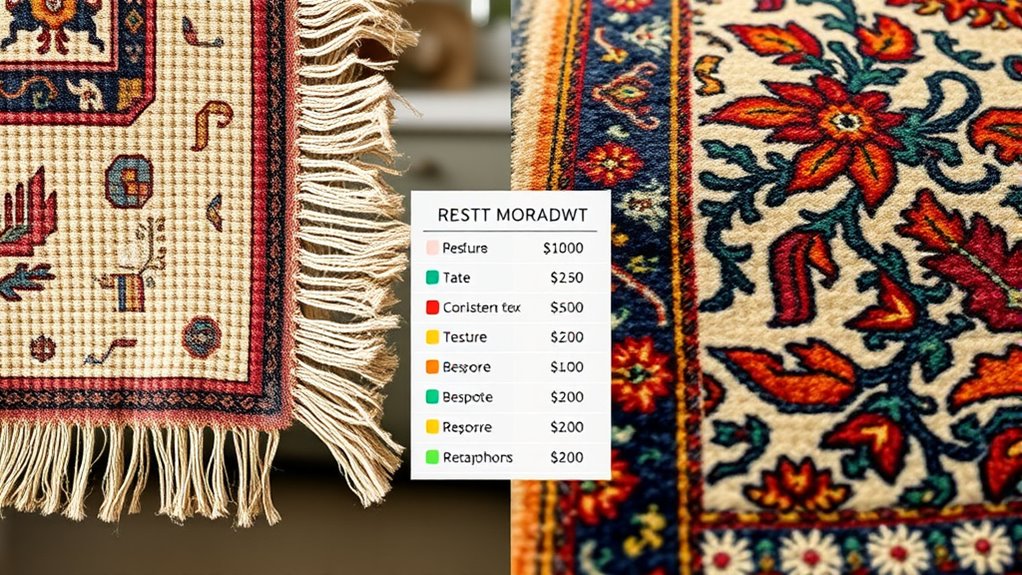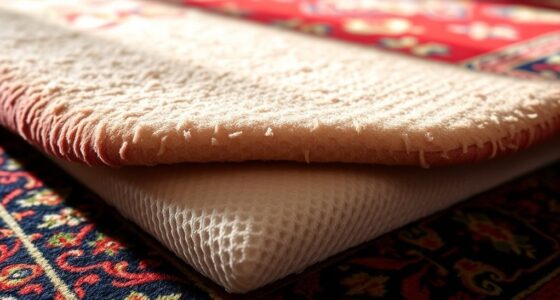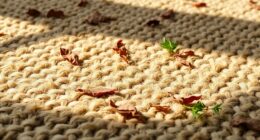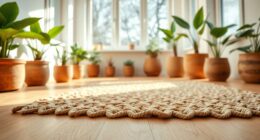Budget rug restoration usually costs less because it uses simpler techniques, lower-quality materials, and faster processes, but it may not last as long or match the original look. Bespoke restoration involves skilled craftsmanship, premium supplies, and detailed customization, making it more expensive but offering better durability and authenticity. Your choice affects long-term value and appearance. Keep exploring to understand the key differences in scope, quality, and costs between these options.
Key Takeaways
- Budget restorations typically use lower-quality materials and faster techniques, reducing costs but potentially sacrificing durability and authenticity.
- Bespoke restorations involve meticulous craftsmanship, premium materials, and customization, leading to higher costs but superior quality and longevity.
- The complexity and intricacy of the rug’s design significantly influence the price difference between budget and bespoke options.
- Urgency and specific customization requests increase costs for both budget and bespoke restorations, with bespoke generally commanding a premium.
- Long-term value favors bespoke restoration due to better materials, craftsmanship, and durability, justifying the higher initial investment.
Understanding the Scope of Restoration Services

To truly grasp the scope of rug restoration services, it’s essential to understand what these processes typically involve. Restoration often includes antique preservation, where specialists carefully clean and repair valuable, aged rugs to maintain their historical integrity. This process guarantees that the rug’s original craftsmanship and stylistic authenticity are preserved, preventing further deterioration. Restoration may involve knot repair, fringe restoration, color touch-ups, and structural reinforcement. Skilled artisans assess each rug’s unique features to determine the best approach, balancing preservation with aesthetic improvement. Whether it’s a delicate antique or a vintage piece, the goal is to restore its beauty and integrity without compromising its original style. The careful handling of natural materials ensures that the rug’s texture and feel remain authentic throughout the restoration process, highlighting the importance of expert care in maintaining a rug’s value and character. Additionally, understanding color integrity is crucial for achieving seamless restoration results that respect the rug’s original appearance. Incorporating modern restoration techniques can further enhance durability and aesthetic appeal while maintaining the rug’s historical essence. Moreover, attention to cultural significance helps ensure that traditional methods are respected and preserved in the restoration process. Recognizing the attention to detail required in quality assurance can significantly impact the success of restoration outcomes.
Material and Fabric Considerations

The quality of materials you choose directly affects the durability and appearance of your rug. Higher-grade fabrics often come with increased replacement costs but offer better longevity. Understanding these material and fabric considerations helps you weigh your options more effectively. For example, using premium textiles can also provide a more refined finish, enhancing the overall aesthetic of your rug. Additionally, selecting materials aligned with industry standards ensures your restoration meets quality benchmarks and offers long-term value.
Material Quality Impact
Material quality plays a crucial role in determining the durability and appearance of your rug during restoration. High-quality materials ensure better material durability, meaning your rug will withstand wear and tear longer. When it comes to fabric selection, choosing premium fibers like wool or silk can considerably enhance the rug’s resilience and aesthetic appeal. Lower-quality fabrics might be cheaper initially but are prone to quicker deterioration, fading, or damage, which can lead to higher long-term costs. The right material choice affects not only how well your rug holds up over time but also the overall restoration outcome. Investing in superior materials during restoration helps preserve the rug’s original beauty and ensures a more lasting, cost-effective result. Additionally, understanding the material composition can guide you in selecting the most suitable options for your specific restoration needs, especially considering certifications and sourcing, which reflect the quality standards of the materials used. Proper consideration of symptoms of deterioration can also help in choosing materials that will better resist common issues like fraying or staining over time.
Fabric Replacement Costs
Fabric replacement costs vary considerably based on the type of fabric chosen and the extent of restoration needed. Higher-quality fabrics or specialty materials can notably increase costs. When considering fabric dyeing, expect additional expenses if you want custom colors or patterns. Fabric treatment, such as stain resistance or UV protection, also adds to the overall price. Maintaining a growth mindset and staying informed about financial metrics can help you make smarter choices about investments in quality fabrics.
Here are key factors influencing costs:
- Fabric type (natural vs. synthetic)
- Complexity of fabric dyeing processes
- Level of fabric treatment required
- Size and condition of the rug
Choosing delicate or rare fabrics will raise expenses, but they can enhance durability and appearance. Carefully evaluate your needs to balance aesthetics with your budget.
Labor and Skill Level Required

Restoring a rug requires varying skill levels depending on the complexity of the work. You’ll find that some repairs demand more time and expertise, especially with intricate designs or delicate fabrics. Specialized techniques are often necessary to achieve a high-quality finish, making skill and experience essential factors in the process. Additionally, understanding divorce process requirements can help you better appreciate the importance of expert guidance in complex tasks. When working with Unique and Wicked Planters, choosing a skilled craftsman ensures the creative details and materials are properly handled and finished. Recognizing the importance of anime culture and storytelling can also influence the restoration process, especially if the design involves intricate or culturally significant motifs.
Skill Level Variations
While both budget and bespoke rug restoration require skilled craftsmanship, the level of expertise and labor involved can vary considerably. In bespoke restoration, you’ll need craftsmen with advanced skill acquisition, mastery of craftsmanship nuances, and years of experience. This often means a higher skill level, with specialists capable of intricate repairs and delicate handling. Additionally, understanding ethical hacking principles can help ensure that restoration processes are secure and transparent throughout the project. This heightened skill level often involves specialized training, which directly impacts the quality and complexity of restoration work. Moreover, the cultural significance of certain rugs may demand even greater expertise to preserve their authenticity and value. Recognizing the hours of operation of local repair shops can also influence scheduling and project timelines, especially for urgent restorations.
Time Investment Needed
The level of skill required directly influences the amount of time needed for rug restoration. If you’re using DIY techniques, expect to spend more time, especially if you’re learning as you go. Restoring a rug with sentimental value often demands patience, as careful attention to detail is essential to preserve its meaning and appearance. A simple repair might take a few hours, but complex restorations can require multiple sessions. Skilled restorers work efficiently because they understand the nuances of different fibers and dyes, reducing overall time. Conversely, amateurs may need extra time to avoid mistakes. Ultimately, the more intricate the restoration and the higher your skill level, the more time you’ll need to dedicate to achieve a quality result.
Specialized Techniques Applied
Applying specialized techniques in rug restoration demands a high level of skill and precision, as each method targets specific types of damage or fabric. You’ll need expertise in areas like color matching to seamlessly blend repairs without compromising the rug’s original look. Techniques such as meticulous knot restoration help preserve antique authenticity, ensuring the piece retains its historical value. Skilled artisans use advanced methods suited for delicate fabrics and intricate patterns.
Here are four key techniques:
- Precise color matching for blending repairs
- Knot restoration to maintain pattern integrity
- Patching and reweaving for damaged areas
- Gentle cleaning to preserve fibers and vibrancy
These techniques require a high skill level, making bespoke restoration more costly but essential for preserving authenticity.
Customization and Detailing Efforts
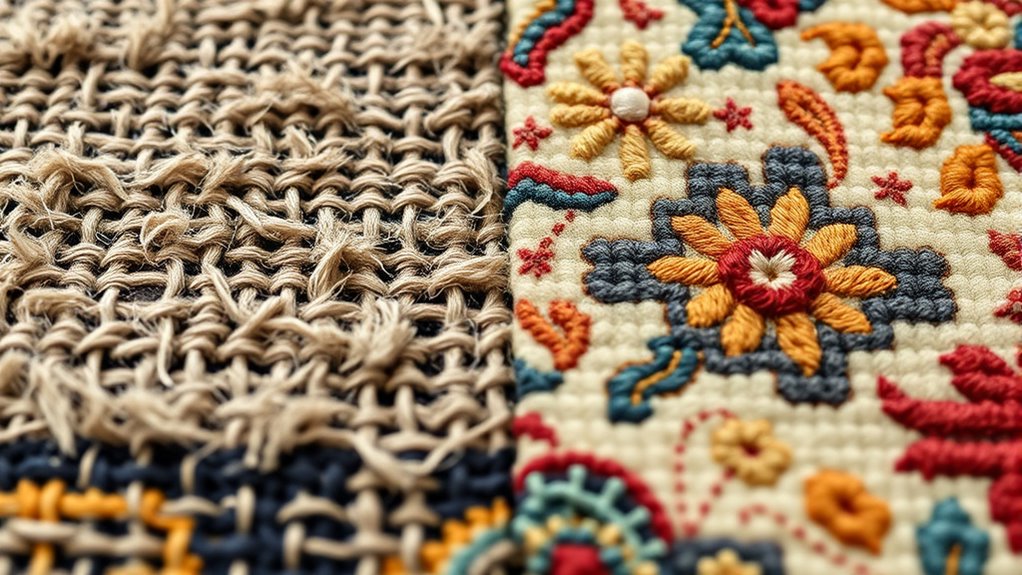
Customization and detailing efforts are at the heart of restoring a rug to its original beauty, allowing you to tailor the process to your specific needs and preferences. Your focus on precise color matching ensures the repaired areas blend seamlessly, while careful pattern alignment maintains the rug’s visual harmony. These meticulous efforts require skilled craftsmanship and attention to detail, often increasing the overall cost but delivering a flawless finish. To illustrate, consider the following aspects:
| Aspect | Impact on Restoration |
|---|---|
| Color Matching | Ensures seamless blending with existing colors |
| Pattern Alignment | Maintains the rug’s original design integrity |
| Detailing Efforts | Adds uniqueness and precision to the repair |
| Customization Level | Reflects your personal preferences and needs |
Quality of Supplies and Finishes

High-quality supplies and finishes are essential to achieving a durable and visually appealing rug restoration. Using premium materials ensures that your vintage patterns stay sharp and authentic, preserving the rug’s character. Proper finishes enhance color matching, making repairs seamless and nearly invisible. When investing in quality, you benefit from better durability and a refined look that lasts. Key aspects include:
- Premium dyes for accurate vintage pattern restoration
- High-grade fibers for longevity and resilience
- Skilled craftsmanship for precise color matching
- Finishing treatments that protect against wear and fading
Choosing superior supplies guarantees your rug maintains its beauty over time, making the restoration worthwhile and visually striking.
Timeframe and Urgency of Completion
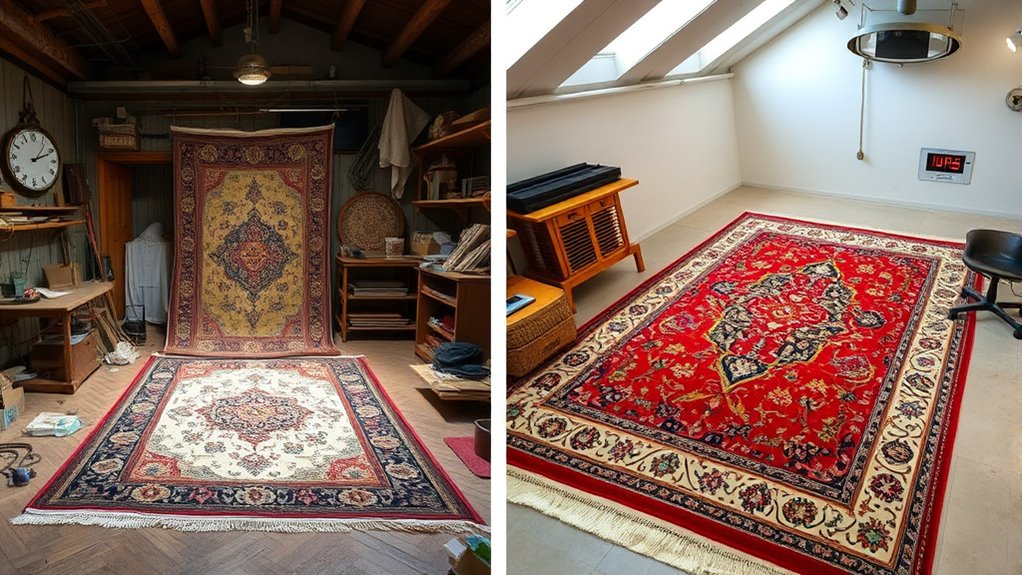
The timeframe for rug restoration directly impacts the quality and outcome of the project. When you need urgent completion, it often influences pricing strategies, as rush jobs typically cost more due to expedited labor and materials. Bespoke restorations, which prioritize meticulous attention to detail, might take longer, aligning with your high customer expectations for quality. Budget options may offer quicker turnaround times but could compromise on thoroughness. Understanding your urgency helps you and your restoration provider set realistic timelines and costs. Clear communication about deadlines ensures that both parties align on expectations, preventing misunderstandings. Ultimately, balancing your desired timeframe with your budget and quality goals ensures you receive a restoration that meets both your needs and standards.
Long-term Durability and Maintenance
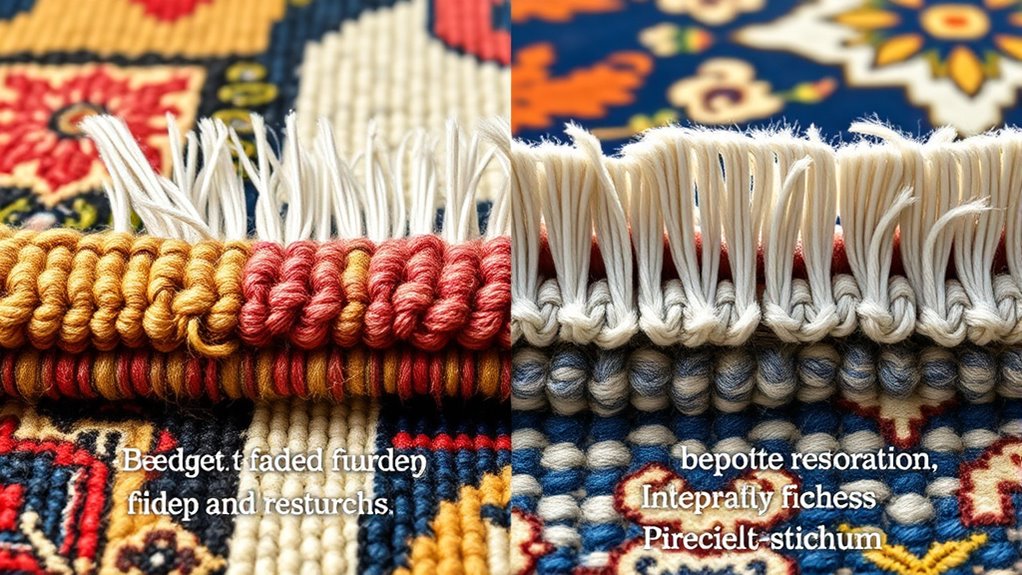
Long-term durability and maintenance are essential considerations when choosing between budget and bespoke rug restoration options. Your decision impacts how well the rug withstands wear and how easy it is to care for over time. Bespoke restoration often uses eco-friendly methods and high-quality materials, enhancing aesthetic appeal and longevity. Budget options might require more frequent repairs, reducing durability. To help you decide, consider these factors:
- Material quality and eco-friendliness
- Resistance to wear and fading
- Ease of cleaning and ongoing maintenance
- Preservation of aesthetic appeal over time
Choosing bespoke restoration can offer better durability and eco-friendly maintenance, ensuring your rug remains beautiful and functional for years to come.
Overall Cost Implications and Value for Money
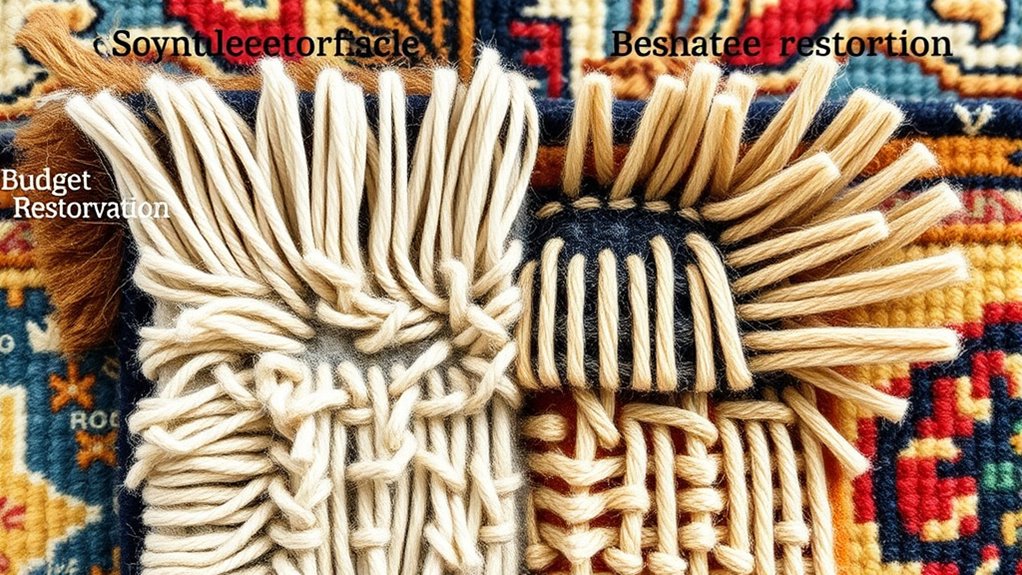
While budget rug restoration may seem more affordable upfront, it often results in higher costs over time due to frequent repairs and replacements. In terms of cost efficiency, investing in bespoke restoration offers better long-term value, reducing the need for ongoing fixes. Although the initial expense might be higher, the quality craftsmanship preserves the rug’s integrity and longevity. Additionally, bespoke restoration enhances the aesthetic appeal, restoring the rug’s original beauty and character. This added value means you get a more durable, visually appealing piece that maintains its worth longer. Ultimately, choosing bespoke restoration provides a smarter investment, balancing initial costs with ongoing savings and enriching your space’s look for years to come.
Frequently Asked Questions
How Do I Determine if My Rug Needs Restoration or Replacement?
To decide if your rug needs restoration or replacement, look for rug damage indicators like deep stains, frayed edges, or persistent odors. If the damage affects the rug’s structure or beauty considerably, restoration urgency increases. You should consult a professional to assess whether repairs can restore its appearance and value or if replacement is a better option. Acting promptly helps preserve your rug’s integrity and prolongs its lifespan.
Are There Eco-Friendly Options Available for Rug Restoration?
Imagine your rug as a living garden needing gentle care. Yes, eco-friendly options exist, using eco-friendly dyes and sustainable materials that nurture your rug without harming the environment. These choices not only preserve its beauty but also support a greener planet. By opting for eco-conscious restoration, you breathe new life into your rug while protecting nature’s delicate balance, making your space both beautiful and environmentally responsible.
What Are the Signs of Poor Craftsmanship in Rug Restoration?
You should watch for craftsmanship flaws like uneven stitching, loose threads, or mismatched colors, which indicate poor work. Repair inconsistencies, such as irregular dyeing or patchy areas, also signal subpar restoration. These issues often result from rushed or careless craftsmanship. If you notice these signs, it’s a good idea to question the restorer’s experience or seek a second opinion to guarantee your rug gets the quality care it deserves.
Can Restoration Techniques Match the Original Rug’S Age and Style?
They say “a picture is worth a thousand words,” and the same applies to rug restoration. You’ll find that skilled restorers use dye matching and technique authenticity to blend new fibers seamlessly, honoring the rug’s original age and style. While perfect replication is challenging, experienced artisans guarantee their techniques respect the rug’s history, making the restoration look authentic and preserving its timeless charm.
How Does Restoration Affect My Rug’S Resale Value?
Restoring your antique rug can boost its resale value if done carefully, preserving its original charm. Proper restoration highlights the rug’s age and craftsmanship, attracting buyers who value authenticity. However, overly invasive or poorly executed work might reduce its appeal and resale price. You should choose experienced restorers to maintain its integrity, ensuring your antique rug remains desirable and retains or increases its value on the resale market.
Conclusion
When choosing between budget and bespoke rug restoration, consider that the latter can be up to 50% more expensive but offers tailored craftsmanship and lasting durability. Remarkably, a well-restored rug can increase your home’s value by up to 10%. While the initial cost might seem high, investing in quality restoration ensures your rug remains beautiful and durable for decades, making it a smart choice for both aesthetics and long-term savings.
